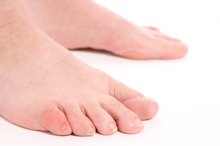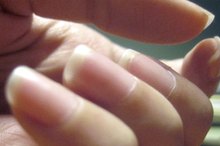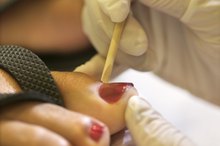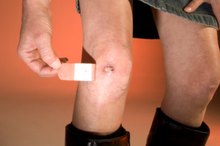A ripped fingernail is painful 2. This problem occurs for many reasons, such as when you hit or jam your finger. If you have long nails, they might catch on something, causing trauma to the fingernail and nail bed. Because nails won't reattach, You need to treat the area carefully to promote nail growth and prevent infection. Fortunately, fingernails grow fast. Growth is about three times faster than with toenails, according to TeensHealth.org.
Filing
Filing the edges of your ripped fingernail will help prevent additional tearing. Trim off the loose part of the nail. Use an emery board, available at most drugstores, to smooth the rough edges. As your nail starts to grow back, keep the edge filed to prevent another injury. Eventually, the ripped area will disappear. Prevent future tears by trimming and filing your nails.
- Filing the edges of your ripped fingernail will help prevent additional tearing.
Soaking
Ingrown Thumbnail
Learn More
After trimming and filing your nail, soak your fingers in warm water mixed with a teaspoon of salt. This helps clean your fingernails. Soak for about 20 minutes, two to three times daily, according to the HealthWise website. After soaking the injured nail, allow it to air-dry before applying medication and a bandage. This will help prevent infection by avoiding excess moisture around the nail.
- After trimming and filing your nail, soak your fingers in warm water mixed with a teaspoon of salt.
- After soaking the injured nail, allow it to air-dry before applying medication and a bandage.
Treating
A ripped fingernail is at risk for infection without proper treatment. Apply an antibiotic ointment daily after soaking the nail. Wash your hands with an antibacterial soap before applying the ointment. If you want to be extra careful, apply the ointment with a clean cotton swab. Once you've applied the ointment, cover the ripped nail with a clean bandage.
- A ripped fingernail is at risk for infection without proper treatment.
- If you want to be extra careful, apply the ointment with a clean cotton swab.
Watching
Ingrown Toenail on the Pinky
Learn More
Watch for signs of infection. Red flags include increased heat and tenderness. Also watch for pus coming from the nail, according to HealthWise. Redness that gets worse over time is also a red flag. Contact your doctor if you have any of these symptoms.
- Watch for signs of infection.
- Also watch for pus coming from the nail, according to HealthWise.
Related Articles
References
- TeensHealth: Skin, Hair and Nails
- Drugs.com: Toenail-Fingernail Removal
- Merck Manual Professional Version. Onychomycosis. Updated August 2019.
- Richardson M. Selecting a treatment option in subungual haematoma management. Nurs Times. 2004;100(46):59, 61, 63.
- MyHealth Alberta.ca. Toenail or fingernail avulsion: Care instructions.
Writer Bio
Nicki Howell started her professional writing career in 2002, specializing in areas such as health, fitness and personal finance. She has been published at health care websites, such as HealthTree, and is a ghostwriter for a variety of small health care organizations. She earned a Bachelor of Science in business administration from Portland State University.









